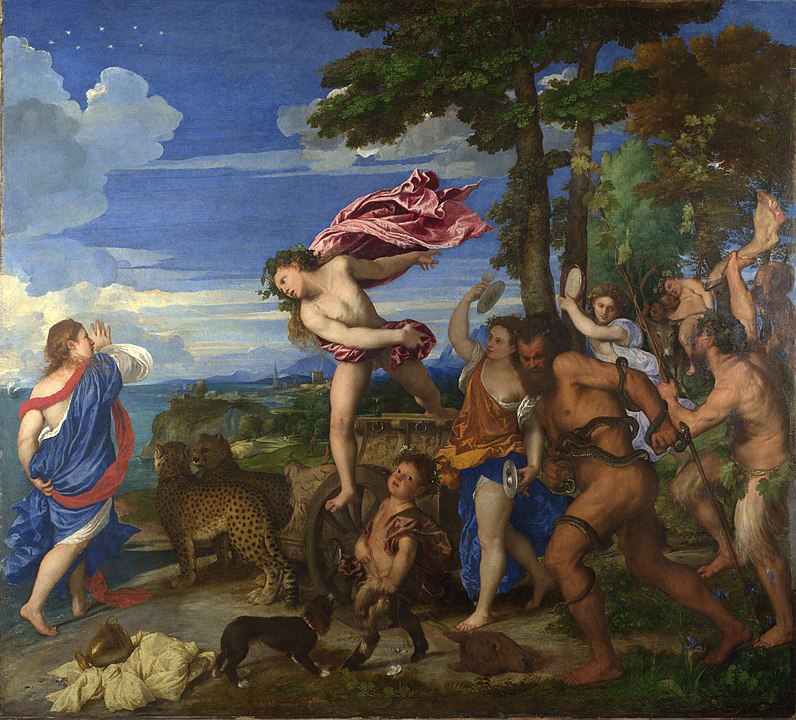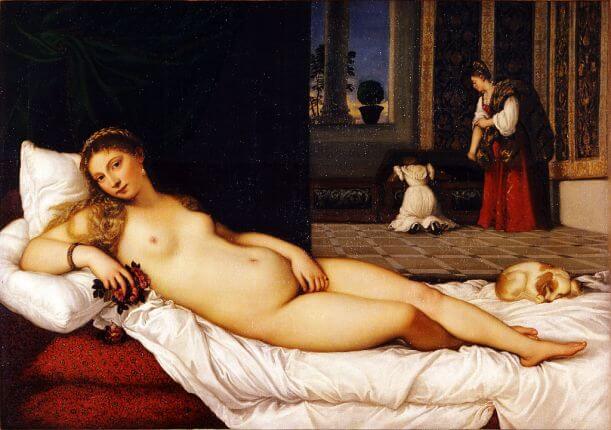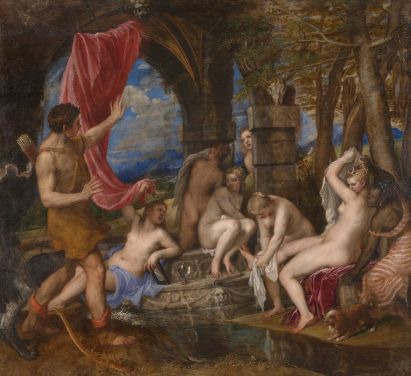|
Where? Room 2 of the National Gallery
When? 1522-1523 Commissioned by? Alfonso d’Este, the Duke of Ferrara, to decorate one of the rooms in his Ducal Palace. What do you see? On the left is Ariadne in a blue dress. She is left behind by Theseus on an island. You can still see the ship of Theseus near the horizon in the middle left of the painting. An almost naked Bacchus is jumping out of his chariot, which is carried by two cheetahs. Bacchus is immediately in love with Ariadne, but Ariadne seems hesitant as she is still dealing with the fact that Theseus left. While her arms and body are still in the direction of the ship of Theseus, her head is turned to Bacchus. Bacchus convinces Ariadne to marry him. Bacchus promises Ariadne to turn the diadem that Ariadne was wearing during their wedding into a constellation of stars, which you can see in the top left of the painting. Bacchus has also brought his entourage of drunk and crazy people on the right. One of his followers is holding the leg with a hoof of a cow that he just ripped off. You can see the head of the cow in the foreground, which is dragged along by a young boy. Completely on the right is a man carrying a barrel of wine and in the foreground, a man is trying to break free from snakes. Backstory: Alfonse d’Este originally commissioned Raphael and Fra Bartolommeu to make this painting but both died before they could start their work. He then decided to give the work to Titian. This painting is based on the mythological stories of the Latin poets Catullus and Ovid. The story is about Princess Ariadne from the Greek island of Crete. She fell in love with Theseus from Athens and helped him to kill the Minotaur. They left together from Crete, but Theseus abandoned her while she was asleep on the Greek island of Naxos. Ariadne was heartbroken when she discovered that Theseus had left and ran along the beach of Naxos to see if she could see any signs of him. At that moment, Bacchus - the god the wine, fertility, madness, theatre, and religious ecstasy - arrived. Bacchus had fallen in love with Ariadne and asked her to marry him. The painting is famous because Titian is able to paint a moment that is frozen in time in a very energetic scene. Notice also the beautiful use of bright color, typical for the School of Venice, which makes this painting come alive.
Symbolism: Bacchus is wearing a crown of ivy leafs, which is the sacred plant to Bacchus to prevent intoxication (which is what people in the past believed that ivy could do). The constellation of stars (which we now refer to as Corona Borealis) on the top left is in the form of the diadem that Ariadne was wearing when she married to Bacchus. It is a symbol of their marriage.
The wine barrel, tambourines, and snakes are all symbols of the lifestyle that Bacchus represents. The cheetahs refer to the collection of wild animals of the commissioner of this painting. Who is Ariadne? According to Greek mythology, Ariadne was the daughter of Minos, who was the King of Crete. Minos had built a labyrinth, with in the center a Minotaur (a creature with the head of a bull and the body of a human). He put his daughter Ariadne in charge of the labyrinth. Following an earlier dispute with Athens, every seven to nine years, 14 noble citizens from Athens were sacrificed to the Minotaur. One year, Theseus, was among these 14 noble citizens. Theseus became a hero as he killed the Minotaur, but to do that, he received help from Ariadne who was in love with him. Ariadne married in the end to Bacchus and gave him about 12 children. After Ariadne died, Bacchus brought her back from the underworld Hades and she became a Greek goddess. Why Bacchus? Bacchus was a chronic alcoholic, which made him a great subject for mythological stories and also for artworks. Bacchus was also the inspiration for popular festivals, called Bacchanalia, which were introduced to Rome in the second century before Christ. These festivals contained a lot of alcohol and nudity and were a popular theme in Renaissance art. Who is Titian? Titian (c. 1489 – 1576) was a painter and greatest member of the Venetian school of painters. He was very talented in painting both portraits and landscapes, which is and was a rare combination. In his teenage years, the Bellini brothers (Gentile and Giovanni) taught him how to paint, but his work was quickly considered to be better than that of the Bellini brothers. Some well-known paintings by Titian are his Venus of Urbino in the Uffizi Museum and Diana and Actaeon which is also in the National Gallery in London.
Fun fact: In the original story on Ariadne and Bacchus, the chariot of Bacchus was drawn by tigers. Instead, Titian painted two cheetahs. This was most likely the case, because Duke Alfonso d’Este did not have tigers, but did have cheetahs, in his menagerie.
Collecting wild and exotic animals, called a menagerie, was an impressive way to show off to your guests. Menageries of that time included animals like panthers, leopards, and elephants. Interested in a copy for yourself? Poster or canvas
Written by Eelco Kappe
References:
0 Comments
Leave a Reply. |
Categories
All
|
- Home
- Blog
-
Museums
- Alte Pinakothek
- Art Institute of Chicago
- Baltimore Museum of Art
- Barber Institute of Fine Arts
- Bargello
- Barnes Foundation
- British Museum
- Church of Sant’Anastasia
- Cleveland Museum of Art
- Courtauld Institute of Art
- Detroit Institute of Arts
- Frans Hals Museum
- Galleria Borghese
- Gallerie dell'Accademia
- Getty Museum
- Guggenheim
- Hermitage Museum
- Kunsthistorisches Museum
- Kunstmuseum Basel
- Legion of Honor Museum
- Louvre
- Mauritshuis
- Metropolitan Museum of Art
- Musee d’Orsay
- Museum of Fine Arts in Boston
- Museum of Modern Art
- National Gallery in London
- National Gallery of Art
- National Museum in Poznań
- Norton Simon Museum
- Ny Carlsberg Glyptotek
- Palace of Versailles
- Palazzo Pitti
- Palazzo Vecchio
- Petit Palais
- Philadelphia Museum of Art
- Prado
- Pushkin Museum
- Ravenna Art Museum
- Rijksmuseum
- San Diego Museum of Art
- Santa Maria delle Grazie
- St. Peter's Basilica
- Städel Museum
- Statens Museum for Kunst
- Tate Britain
- Tate Modern
- Timken Museum of Art
- Uffizi
- Vatican Museums
- Wallace Collection
-
Artists
- Altdorfer
- Anguissola
- Berlin Painter
- Bosch
- Botticelli
- Boucher
- Bronzino
- Bruegel the Elder
- Brunelleschi
- Cabanel
- Caillebotte
- Canova
- Caravaggio
- Carpeaux
- Cezanne
- Cimabue
- David
- Degas
- Delacroix
- De Maria
- Donatello
- El Greco
- Fontana
- Fra Angelico
- Fragonard
- Gauguin
- Gentileschi
- Gericault
- Gonzalez-Torres
- Goya
- Hals
- Hogarth
- Hokusai
- Ingres
- Leonardo da Vinci
- Lippi, Filippo
- Longhi, Barbara
- Lorrain
- Makovsky
- Manet
- Massys
- Matisse
- Merian
- Michelangelo
- Mochi
- Modigliani
- Monet
- Panini
- Parmigianino
- Perugino
- Picasso
- Pisanello
- Raphael
- Rembrandt
- Renoir
- Reynolds
- Rivera
- Rodin
- Rubens
- Scultori
- Seurat
- Steen
- Tintoretto
- Titian
- Toulouse-Lautrec
- Turner
- Uccello
- Van der Weyden
- Van Dyck
- Van Eyck
- Van Gogh
- Van Hemessen
- Vasari
- Velazquez
- Vermeer
- Veronese
- Vigée Le Brun
-
Locations
- Books
- About Us



